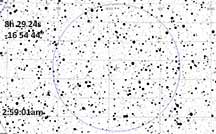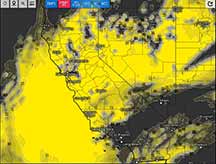




This is a high value LuckyStar event by a Trojan asteroid, and special effort should be made if we're in clouds but able to get clear with some driving. However, Santa Cruz is right on the centerline of the rather wide path. MIRA is inside but near the southern limit and would be valuable for this reason too. RECON will no doubt be involved also. Also the other NorCal observers and Jerry B are inside the path. All 3 of "Team Santa Cruz should try this from different locations. Kirk and I should separate somehow. The altitude is 22 degrees so Karl may need to move some as well.
Remember, we don't know much about Trojan asteroids. Moons? We don't know. So be sure to start taping 2 minutes before and keep going till 2 minutes after. I also note that the early ephemeris had this event at 3:01am and now OW gives it at 2:59:01am, 2 minutes earlier. The LuckyStar prediction page also agrees with OW, at 2:59:01am for Santa Cruz. Still, if there's any uncertainty we may need extra time for that reason too.
It's on the first day of Spring semester and my teaching at Cabrillo so I can't afford to make TOO big a trip. The object is at altitude 22 degrees in the southwest, which is not accessible from my home. So I will be driving up Empire Grade to the Upper Meadow UCSC to get this. Kirk has placed himself at home, where he has a good western horizon. I've placed an OW icon at Karl's position at home, assuming he can get it between trees somehow. If not, this is a high value event and I would hope he's willing to drive up to the Hogback to get a clear horizon for this important event. The more reliable ECMWF prediction for cloud distributions at event time are below, as of 12am Jan 28. Clear skies for Santa Cruz and along the path into Utah.
Here is the LuckyStar prediction page for MIRA Observatory. Reminder; all charts below assume an Alt/Az telescope, and no diagonal in the cassegrain system for the detector, but does include a diagonal in the system for the "circle" eyepiece chart. The MIRA instruments will have a much smaller field of view. I don't know if they can be able to try this one, but I will notify and link this page. I don't know if they are going / or did plan to do this. My guess is - not. Dan Cotton and Jean Perkins have talked about perhaps writing a grant to build their own "occultation box", but I've not heard from them since November '23. I don't believe they are equipped yet, but I do believe they have a video camera but not 1pps GPS time stamping capability.
 |
 |
 |
 |
 |
We had clear skies after the daytime clouds cleared. By 3am it was totally clear.
I used my Watec 910hx version 3 PAL video camera, feeding a miniDV Canon MVI camcorder, with IOTA VTI latest version for time stamps. The Watec was at the back of the Celestron 8SE telescope and f/3.3 focal reducer. I did not take a dark video nor flat video (sorry!). I drove up to the Upper Meadow UCSC and set up my table and scope 20 ft down the bike path on the WEST side of Empire Grade, the little bike path that says it's closed, not the road/bikepath behind the gate. This gave me a good view of Puppis in the south west. I had no trouble with field ID, and at 4x the target was easily followed. I didn't think I'd get a significant advantage at 2x, so I recorded at 4x (2 frames per output integration. So that each point in the PyOTE light curve corresponds to 2 frames, each frame being a 1/25 second image.
I recorded a 5.81s occultation at the expected time.
I used 4px static fixed apertures in PyMovie. Used star='ref1' (closest to the target star) for my reference star. Below was output onto the PyOTE log file and copied here...
magDrop report: percentDrop: 86.8 magDrop: 2.198 +/- 0.330 (0.95 ci)
DNR: 3.06
D time: [10:58:58.2157]
D: 0.6800 containment intervals: {+/- 0.0245} seconds
D: 0.9500 containment intervals: {+/- 0.0669} seconds
D: 0.9973 containment intervals: {+/- 0.1605} seconds
R time: [10:59:04.0241]
R: 0.6800 containment intervals: {+/- 0.0245} seconds
R: 0.9500 containment intervals: {+/- 0.0669} seconds
R: 0.9973 containment intervals: {+/- 0.1605} seconds
Duration (R - D): 5.8084 seconds
Duration: 0.6800 containment intervals: {+/- 0.0368} seconds
Duration: 0.9500 containment intervals: {+/- 0.0850} seconds
Duration: 0.9973 containment intervals: {+/- 0.1858} seconds
I note that my formal timing confidence intervals are tighter at my 4x setting than for Kirk at 8x. However, Kirk's 8x was not really twice the interval as mine, since his equipment was at EIA at 30fps, mine at PAL at 25fps. Still, his time intervals were longer and this may have affected his timing precision. This was not a short event, when we do have a short event, like less than 1sec, it seems to require a low setting even if you think it's too low and you can't see the star well. The software won't find an event if there are too few points to show it. Better that they be noisy but still had an overall lower central level to them, than too few points and so random noise could still prevent significant passage of the FP test. There's no better exampe of this than the Callisto event 2 weeks ago. We had significant noise. Really, noise that was arguably too high to say much of anything. Yet, the dip was still there in the data, and the sampling rate was so high, that even a 0.08mag event was rated comfortably passing the FP test.
So, my caution to Kirk is to be careful about obeying Dave H's advice to go longer on integration settings. The advantage of reducing sky subtraction noise is reasonable, but it can be a poor trade off in the end, for some short events. If the sky is quite dark, especially.
 |
 |
 |
 |
 |
 |
 |
 |
Kirk set up at home, and also got a solid occultation, of 5.87s duration. He set at 8x, half the time resolution, but othersize under similar skies just about 4 miles south of my position, but near sea level as well. As always, he sends in his own data to IOTA and LuckyStar.
DNR=3.04
D 10:58:57.8192 (0.0389, 0.1053, 0.2500)
R 10:59:03.6197 (0.0389, 0.1053, 0.2500)
 |
 |
 |
 |
 |
Had trouble with intermittant power to the equipment, and recovering from this didn't leave enough time to get the occultation. No data.
The Observations are now reviewed and published on the IOTA site. Good ellipsoid fit!